Identification of Aim2 as a sensor for DNA vaccines
- PMID: 25488991
- PMCID: PMC4282968
- DOI: 10.4049/jimmunol.1402530
Identification of Aim2 as a sensor for DNA vaccines
Abstract
Recent human study data have re-established the value of DNA vaccines, especially in priming high-level Ag-specific Ab responses, but also raised questions about the mechanisms responsible for such effects. Whereas previous reports have shown involvement of downstream signaling molecules in the innate immune system, the current study investigated the role of absent in melanoma 2 (Aim2) as a sensor for DNA vaccines. The Aim2 inflammasome directs maturation of the proinflammatory cytokines IL-1β and IL-18 and an inflammatory form of cell death called pyroptosis. Both the humoral and cellular Ag-specific adaptive responses were significantly reduced in Aim2-deficient mice in an IL-1β/IL-18-independent manner after DNA vaccination. Surprisingly, Aim2-deficient mice also exhibited significantly lower levels of IFN-α/β at the site of injection. These results indicate a previously unreported link between DNA vaccine-induced pyroptotic cell death and vaccine immunogenicity that is instrumental in shaping the Ag-specific immune response to DNA vaccines.
Copyright © 2015 by The American Association of Immunologists, Inc.
Figures
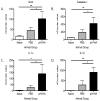
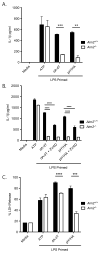

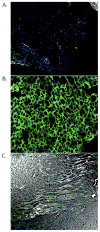
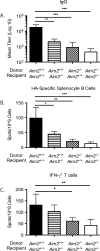
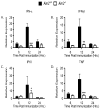
Similar articles
-
Role of AIM2 inflammasome in inflammatory diseases, cancer and infection.Eur J Immunol. 2019 Nov;49(11):1998-2011. doi: 10.1002/eji.201848070. Epub 2019 Aug 14. Eur J Immunol. 2019. PMID: 31372985 Free PMC article. Review.
-
AIM2 senses Brucella abortus DNA in dendritic cells to induce IL-1β secretion, pyroptosis and resistance to bacterial infection in mice.Microbes Infect. 2019 Mar;21(2):85-93. doi: 10.1016/j.micinf.2018.09.001. Epub 2018 Sep 22. Microbes Infect. 2019. PMID: 30248400 Free PMC article.
-
Cytokine secretion and pyroptosis of cholesteatoma keratinocytes mediated by AIM2 inflammasomes in response to cytoplasmic DNA.Mol Med Rep. 2021 May;23(5):344. doi: 10.3892/mmr.2021.11983. Epub 2021 Mar 24. Mol Med Rep. 2021. PMID: 33760111 Free PMC article.
-
Critical role of ASC inflammasomes and bacterial type IV secretion system in caspase-1 activation and host innate resistance to Brucella abortus infection.J Immunol. 2013 Apr 1;190(7):3629-38. doi: 10.4049/jimmunol.1202817. Epub 2013 Mar 4. J Immunol. 2013. PMID: 23460746
-
Inflammasome activation and metabolic disease progression.Cytokine Growth Factor Rev. 2014 Dec;25(6):699-706. doi: 10.1016/j.cytogfr.2014.07.020. Epub 2014 Aug 12. Cytokine Growth Factor Rev. 2014. PMID: 25156419 Review.
Cited by
-
Inflammasome-Mediated Immunogenicity of Clinical and Experimental Vaccine Adjuvants.Vaccines (Basel). 2020 Sep 22;8(3):554. doi: 10.3390/vaccines8030554. Vaccines (Basel). 2020. PMID: 32971761 Free PMC article. Review.
-
Mitochondria, Oxidative Stress and Innate Immunity.Front Physiol. 2018 Oct 18;9:1487. doi: 10.3389/fphys.2018.01487. eCollection 2018. Front Physiol. 2018. PMID: 30405440 Free PMC article. Review.
-
Exploration of Pattern Recognition Receptor Agonists as Candidate Adjuvants.Front Cell Infect Microbiol. 2021 Oct 6;11:745016. doi: 10.3389/fcimb.2021.745016. eCollection 2021. Front Cell Infect Microbiol. 2021. PMID: 34692565 Free PMC article. Review.
-
Inflammasomes and adaptive immune responses.Nat Immunol. 2021 Apr;22(4):412-422. doi: 10.1038/s41590-021-00869-6. Epub 2021 Feb 18. Nat Immunol. 2021. PMID: 33603227 Review.
-
Analysis of the effect of promoter type and skin pretreatment on antigen expression and antibody response after gene gun-based immunization.PLoS One. 2018 Jun 1;13(6):e0197962. doi: 10.1371/journal.pone.0197962. eCollection 2018. PLoS One. 2018. PMID: 29856790 Free PMC article.
References
-
- Wang R, Epstein J, Baraceros FM, Gorak EJ, Charoenvit Y, Carucci DJ, Hedstrom RC, Rahardjo N, Gay T, Hobart P, Stout R, Jones TR, Richie TL, Parker SE, Doolan DL, Norman J, Hoffman SL. Induction of CD4(+) T cell-dependent CD8(+) type 1 responses in humans by a malaria DNA vaccine. Proceedings of the National Academy of Sciences of the United States of America. 2001;98:10817–10822. - PMC - PubMed
-
- Wang S, Kennedy JS, West K, Montefiori DC, Coley S, Lawrence J, Shen S, Green S, Rothman AL, Ennis FA, Arthos J, Pal R, Markham P, Lu S. Cross-subtype antibody and cellular immune responses induced by a polyvalent DNA prime-protein boost HIV-1 vaccine in healthy human volunteers. Vaccine. 2008;26:1098–1110. - PMC - PubMed
Publication types
MeSH terms
Substances
Grants and funding
LinkOut - more resources
Full Text Sources
Other Literature Sources
Miscellaneous

